Key takeaways:
- Engaging youth in charity requires creating spaces for expression and fostering emotional connections to inspire commitment.
- Addressing youth homelessness is critical for personal development, as stability impacts their future potential and mental health.
- Collaboration with local organizations and businesses enhances support systems for youth, providing essential resources and a sense of belonging.
- Successful youth advocacy involves building relationships, patience, and empowering young voices to create and lead initiatives in their communities.
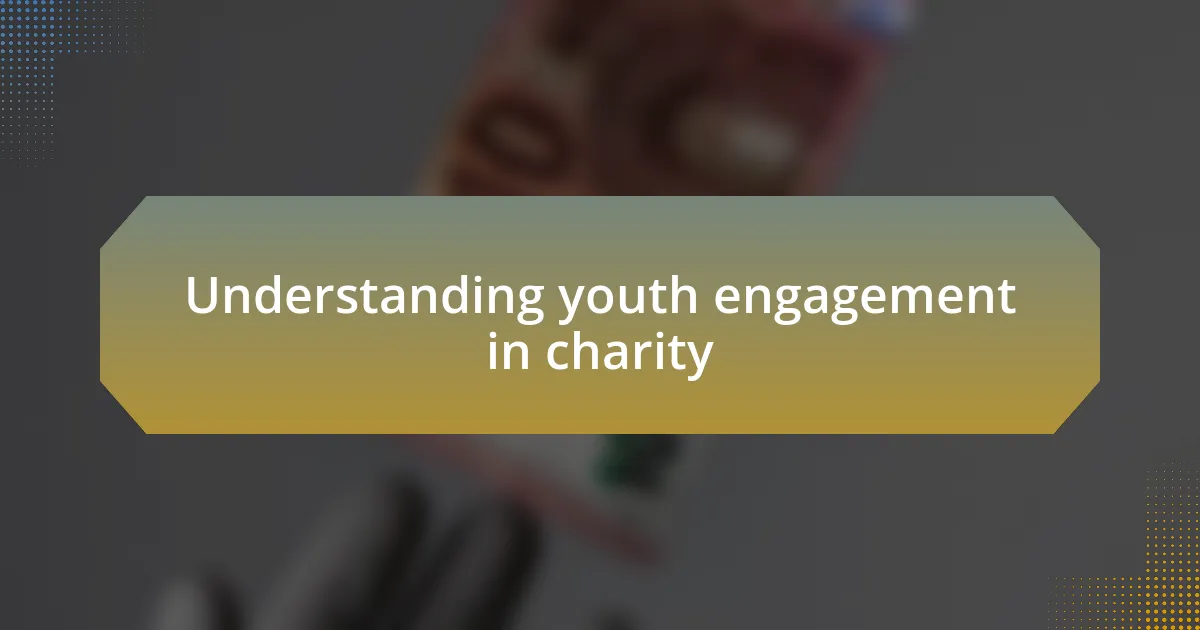
Understanding youth engagement in charity
Youth engagement in charity is not just about volunteer hours or donations; it’s about igniting passion and fostering a sense of ownership among young people. I remember my first experience volunteering; the thrill of actively contributing while also learning about the challenges faced by those less fortunate was transformative. How can we expect youth to advocate for change if they don’t feel their voices are valued?
Engaging young people means creating spaces where they can express their ideas and concerns. I’ve seen firsthand how a simple brainstorming session with youth can lead to innovative solutions that adults might overlook. Isn’t it fascinating to consider what fresh perspectives these young minds can bring when their inputs are genuinely welcomed?
Moreover, emotional connections play a vital role in keeping youth involved in charitable activities. I once participated in a project where we shared stories from those experiencing homelessness. It was moving to watch the youth’s reactions as they began to empathize deeply with the individuals. How can we tap into these emotions to inspire lasting commitment to charitable causes?
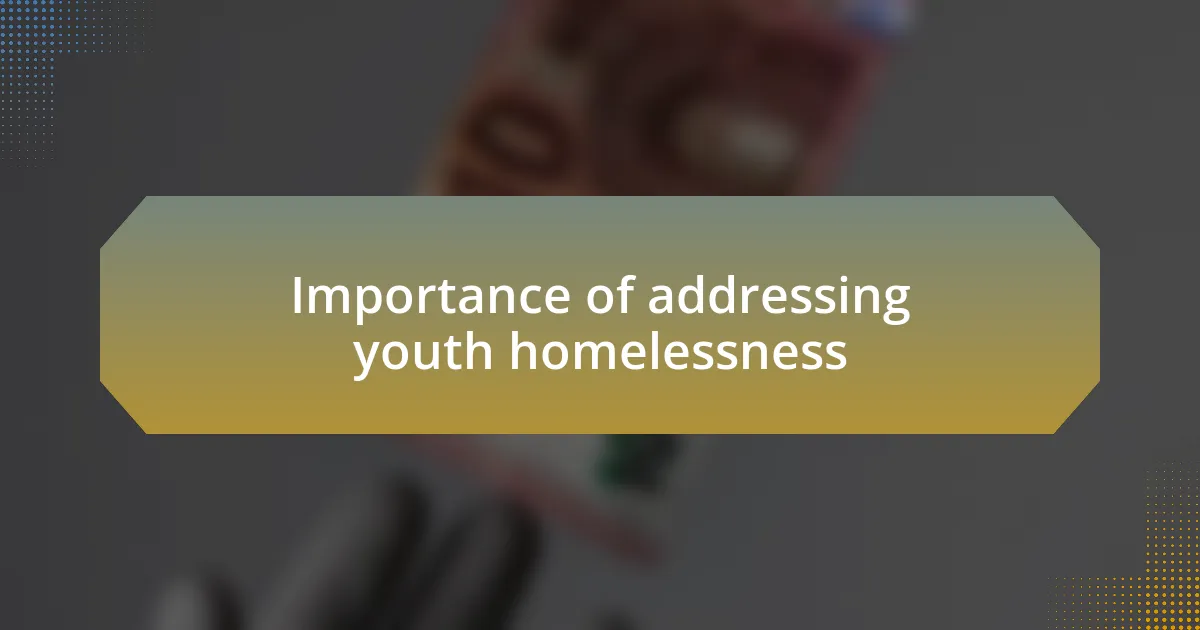
Importance of addressing youth homelessness
Addressing youth homelessness is crucial because these young individuals are at a pivotal point in their lives. I recall meeting a 17-year-old who had already been through several unstable living situations. Listening to his story made me realize how critical stability is for personal development; without it, the potential for their future can dim significantly. Why should we allow our future leaders and innovators to struggle in the shadows of society?
The impacts of youth homelessness extend beyond immediate needs for shelter and food. In my volunteer work, I’ve seen how homelessness can lead to gaps in education, mental health issues, and a cycle that’s hard to break. When I once facilitated a workshop for youth dealing with homelessness, many expressed feelings of hopelessness. It struck me then: how can we build a brighter future when we ignore the struggles of those who will shape it?
Furthermore, addressing youth homelessness fosters a sense of community for everyone involved. During a community event I organized, I was amazed to see youth from various backgrounds come together to support their peers who were experiencing homelessness. It was a beautiful reminder that when we unite to tackle these issues, not only do we uplift those in need, but we also cultivate compassion and understanding among ourselves. How powerful is that?
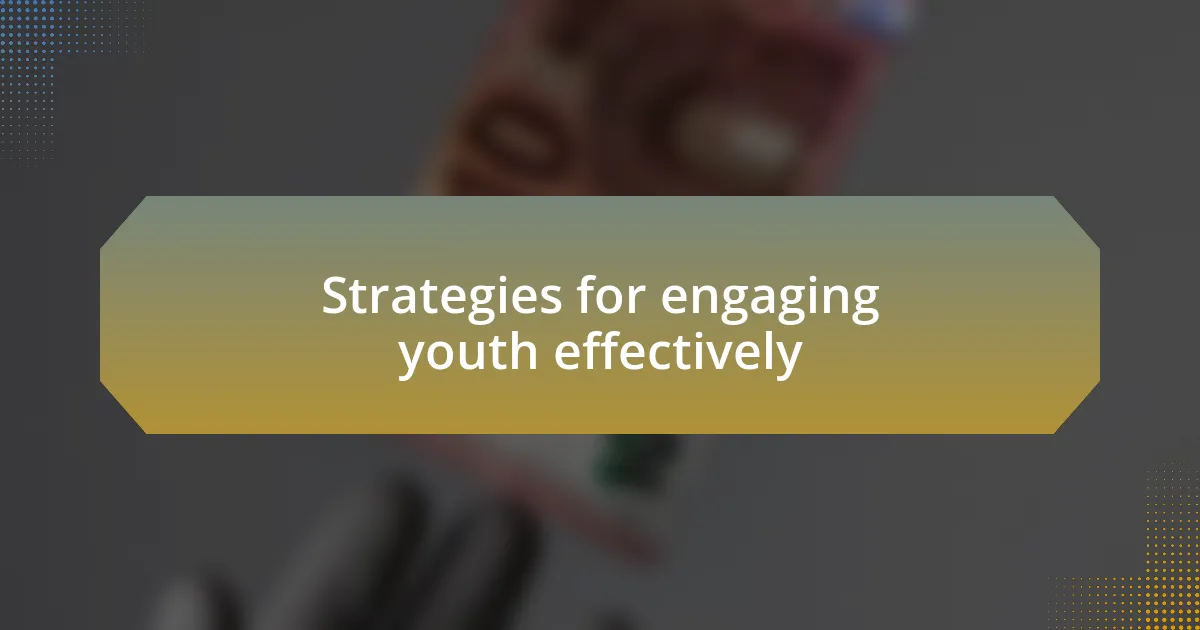
Strategies for engaging youth effectively
Creating effective strategies for engaging youth requires a personal touch. I remember a project where we invited young people to share their stories creatively, through art and poetry. This approach not only helped them express their experiences but also made them feel valued and heard. Isn’t it amazing how art can build bridges and foster connections?
Building peer networks is another strategy that has proven beneficial. I once facilitated a program where youth experiencing homelessness became mentors to one another. It was incredible to witness them developing relationships based on shared experiences. They weren’t just participants; they became advocates for each other. How empowering is it when they realize their voices matter?
Involving youth in decision-making processes is fundamental as well. During a town hall meeting I organized, I sat beside them as they voiced their concerns and suggestions for local programs. The look of pride on their faces was unforgettable. It affirmed my belief that when we include youth in shaping the solutions that affect them, we not only spark their interest but also inspire a sense of ownership and responsibility. Isn’t that the kind of engagement that can transform lives?
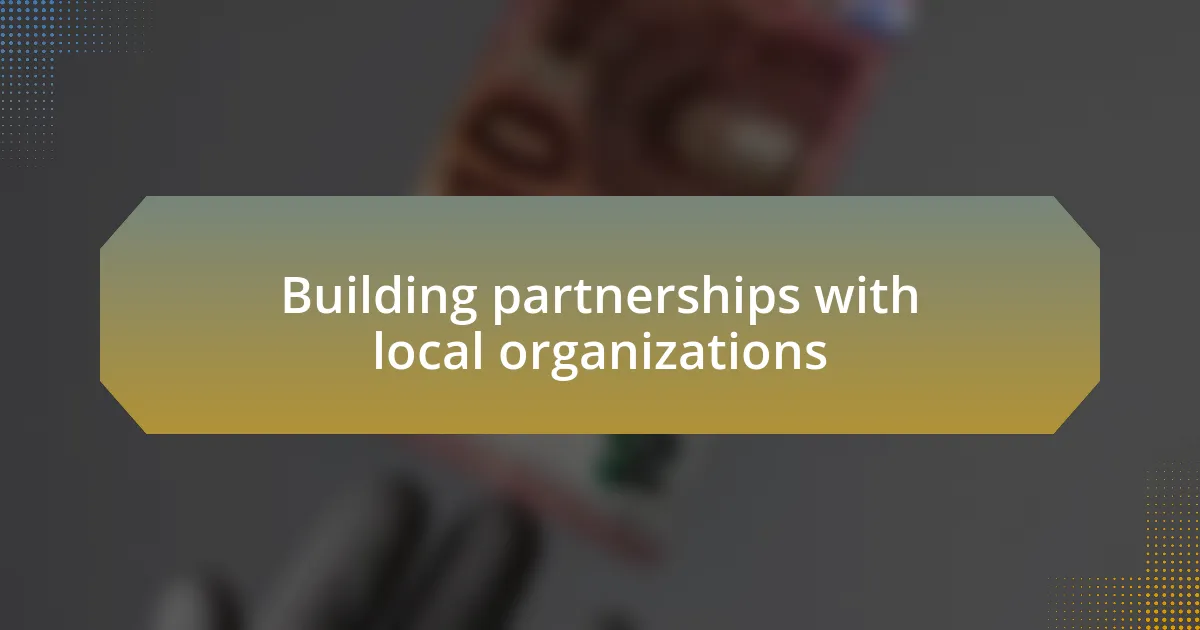
Building partnerships with local organizations
Establishing partnerships with local organizations is essential for creating a robust support system for youth experiencing homelessness. I vividly recall a collaboration with a nearby community center where staff not only provided resources but also welcomed youth to participate in their programs. This synergy fostered an environment where young people felt a palpable sense of belonging. How powerful it is when communities unite for a common cause!
I found that building relationships with local nonprofits added immense value to our efforts. During one initiative, we joined forces with a food bank, allowing us to offer nutritious meals alongside workshops on life skills. The smiling faces of youth who not only filled their stomachs but also gained practical knowledge were testament to the collaboration’s success. Isn’t it rewarding to see tangible results from teamwork?
Moreover, I learned that local businesses can also play a crucial role in these partnerships. I approached a local shop owner who generously donated supplies for our art program. One evening, as we painted together, I felt a unique warmth in the room; it was more than just art supplies—it was the connection we were fostering across our community. How often do we overlook these opportunities to create lasting impacts?
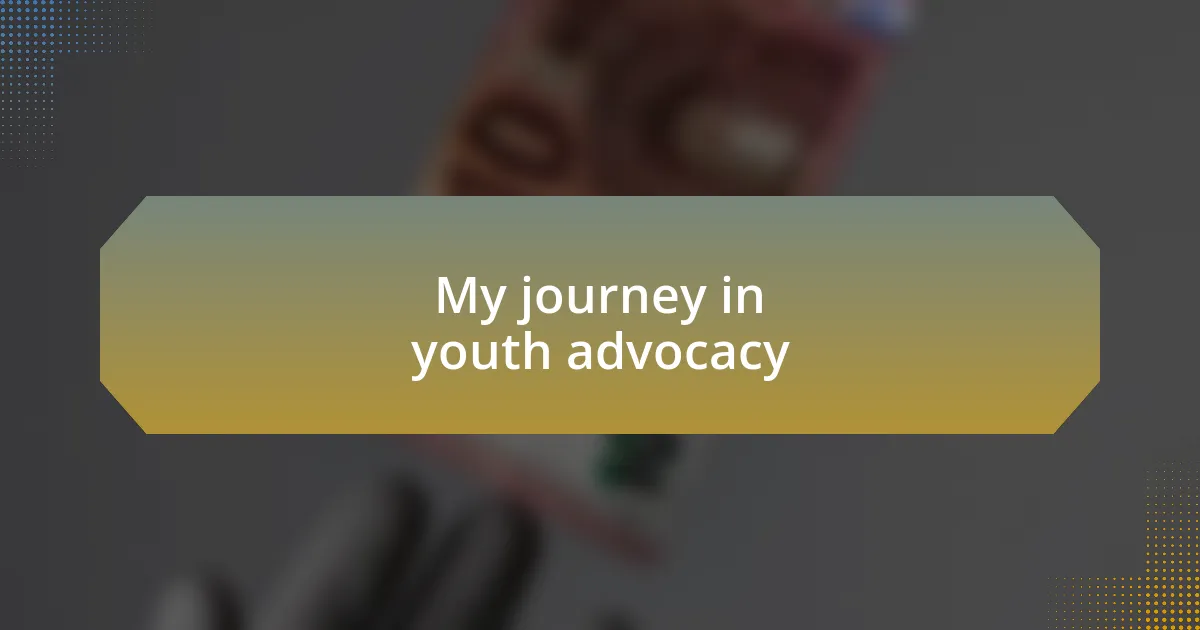
My journey in youth advocacy
My journey in youth advocacy began when I stumbled upon a volunteer opportunity at a local shelter. I remember the first time I sat down to talk with some young individuals who were experiencing homelessness. Their stories were heartbreaking yet filled with resilience, and it struck me how often their voices went unheard. It sparked a fire in me to ensure that their experiences were shared and valued.
As I immersed myself deeper in advocacy, I participated in a youth-led conference that opened my eyes to the power of collective action. I felt a rush of empowerment as I watched young people share their narratives, advocating for their needs and aspirations. That sense of unity inspired me to channel my energy into creating platforms where youth could not only speak but be listened to. Have you ever witnessed the transformative power of young voices standing together?
Through these experiences, I learned that the heart of youth advocacy lies in building genuine relationships. I recall a particularly moving moment when a young person shyly shared their struggles during a workshop I facilitated. The raw emotion in their voice resonated with everyone, reminding me how important it is to create safe spaces for honest dialogue. Isn’t it profound how a single voice can resonate and encourage others to find their strength?
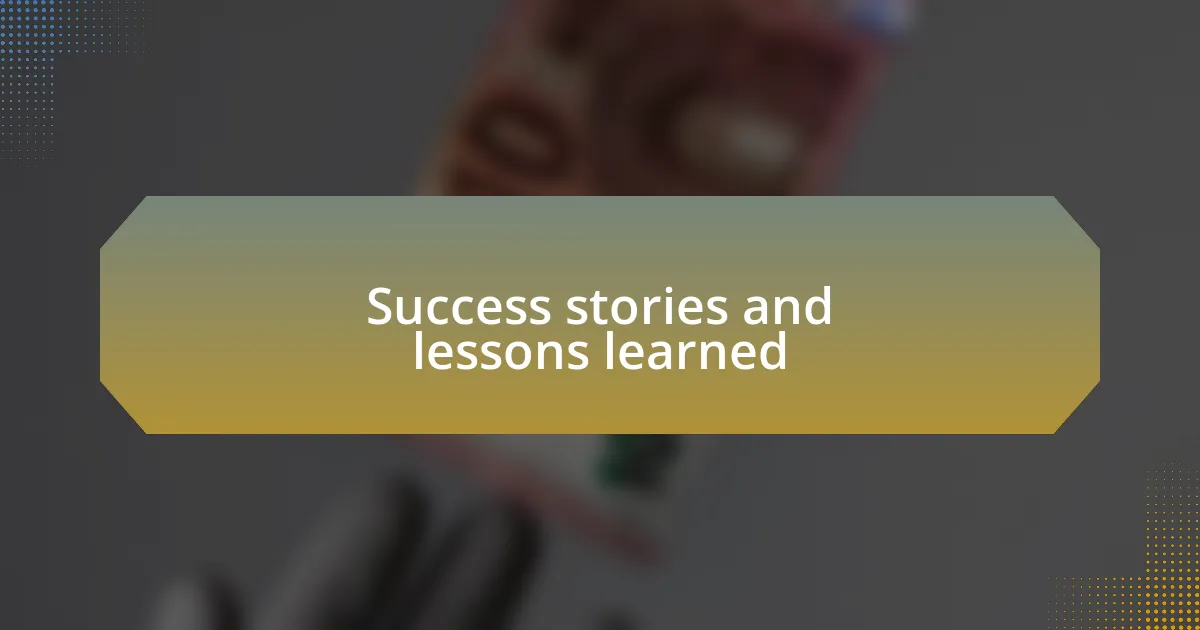
Success stories and lessons learned
Success stories in youth advocacy often emerge from unexpected places. I remember a young girl named Mia, who, after participating in one of our outreach programs, organized her own neighborhood meeting. She gathered friends and local residents to discuss homelessness, leading to a community initiative that brought resources to those in need. Watching her take ownership of that project reinforced my belief that when young people are empowered, they can be catalysts for change. How incredible is it that one individual can ignite a movement?
One of the most significant lessons I’ve learned is the importance of collaboration. When I partnered with local schools to create engagement programs, I saw firsthand how different perspectives enrich discussions. In one session, a high school student shared their own family struggles with housing instability. That moment shattered preconceived notions in the room and fostered compassion among peers. Have you ever noticed how sharing our vulnerabilities helps us connect more deeply?
Through these experiences, I’ve come to understand the necessity of patience in advocacy. It took weeks of effort organizing a community forum before I saw any significant turnout. But when that evening finally arrived, I was moved by the sheer number of young voices eager to speak up. Their engagement reminded me that persistence often pays off, even when the results aren’t immediately visible. Isn’t it inspiring to think about how dedication can lead to unforeseen connections and conversations?
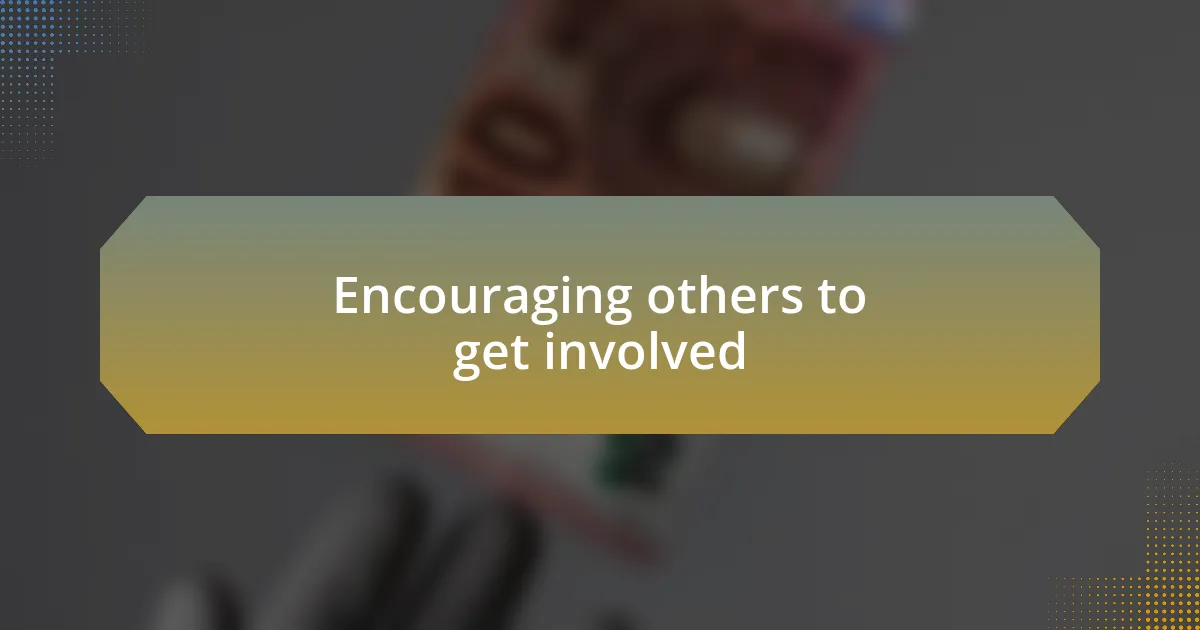
Encouraging others to get involved
Encouraging others to get involved starts with sharing personal stories that resonate. I once met Jamie, a passionate advocate who used her social media platform to raise awareness about youth homelessness. Her heartfelt posts not only educated her followers but also inspired several to volunteer at local shelters. It’s incredible how one person’s passion can ripple through a community, isn’t it?
I find that hosting open forums or workshops can be a game-changer. At one event, I facilitated a discussion where attendees could express their thoughts on homelessness without judgment. The honesty and openness in that room were palpable, as people shared their motivations for getting involved. It struck me how powerful it is to create a safe space for dialogue. Have you ever considered how much participants can learn from each other’s experiences?
Sometimes, a simple call to action is all it takes. I vividly remember sending out a newsletter encouraging readers to donate clothing for homeless youth. The response was overwhelming, with bags of warm coats and blankets piling up. It was a beautiful reminder that people genuinely want to make a difference, often just waiting for an opportunity to do so. Don’t you think that tapping into that inherent desire is the key to driving engagement?